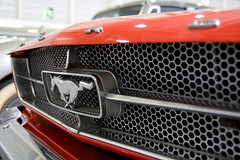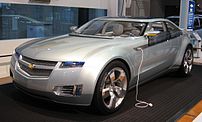 Image by bkdc via Flickr
Image by bkdc via Flickr
The announcement was made at the 12th annual C5/C6 Corvette Birthday Bash, held at the National Corvette Museum, in Bowling Green, Ky.
The new Grand Sport combines the Corvette’s LS3-based powertrain with unique, wide-body styling and a racing-bred suspension for a distinctive model that delivers a great balance of road and race track performance. It is offered in both coupe and convertible body styles, with either a six-speed manual or six-speed automatic transmission. The LS3 6.2L engine is rated at 430 horsepower (321 kW)* and 424 lb.-ft. of torque (575 Nm)* with the standard exhaust system. An optional two-mode exhaust system elevates the power ratings to 436 horses (325 kW) and 428 lb.-ft. (580 Nm).
The Grand Sport replaces the Corvette’s previous Z51 package and brings a greater degree of handling performance, with wider wheels and tires; revised shock, stabilizer bar and spring specifications; and specific gearing. The equipment enables cornering capability of 1.0 g, as well as a 0.2-second improvement in 0-60 acceleration vs. standard LS3-powered models.
Grand Sport coupe models equipped with the manual transmission are uniquely outfitted for race track competition, too, with a dry-sump oiling system, differential cooler and a rear-mounted battery.
The complete list of content and special features for the Grand Sport includes:
- Wider front and rear fenders – including specific front fenders with integrated Grand Sport badges
- Z06-style front splitter and tall rear spoiler
- Functional brake ducts and extra cooling
- Unique 18-inch front and 19-inch rear wheels; painted finish standard and chrome finish optional
- Large 275/35ZR18 tires in front and 325/30ZR19 tires in the rear
- Z06-size brakes, including 14-inch (355 mm) front rotors with six-piston calipers and 13.4-inch (340 mm) rear rotors with four-piston calipers
- Specific manual transmission gear ratios
- Specific rear axle ratio on automatic-equipped models
With its special equipment, the Grand Sport offers a unique blend of performance and amenities. Its suspension package approaches that of the Z06, but includes a removable roof on coupes (Z06 has a fixed roof) and, of course, the availability of a convertible body style. Also, the paddle-shift six-speed automatic transmission is offered, while a manual transmission is the only choice with the Z06.
All of Corvette’s exterior colors are offered on the Grand Sport, and an available Heritage package adds iconic front fender hash marks offered in four colors, as well as two-tone seats with Grand Sport embroidery. The Grand Sport can be ordered with 1LT, 2LT, 3LT and 4LT trim packages, too.
Grand Sport history
Envisioned by legendary Corvette engineer Zora Arkus-Duntov as a factory-built, lightweight and race-ready production model that would trump domestic and foreign road-racing competitors, the original Corvette Grand Sport was a promising idea that led to the production of five special prototypes in 1963. The project was later shelved, following GM’s agreement to stay out of manufacturer-backed motorsports.
The five prototypes were based on the styling of the 1963 Corvette and were hand-assembled under Duntov’s watchful eye. But while they looked like production models, the prototypes were purpose-built race cars that shared little with their assembly-line cousins. Duntov also oversaw the Grand Sport engine program that featured a special, 377-cubic-inch small-block V-8 with side-draft carburetors.
Although never officially sanctioned by General Motors, the five Grand Sport prototypes saw extensive racing experience throughout the 1960s in the hands of “private” racers who had strong contacts within Duntov’s engineering circle. All five original cars are accounted for today and are among the most valuable in the collector market.
Chevrolet offered a limited-edition Grand Sport production model in 1996, commemorating the original racing cars and marking the end of the C4 era in Corvette production. All of the 1,000 examples were painted Admiral Blue and featured a white center stripe and red “hash mark” graphics on the left front fender, a graphic scheme that mimicked the look of some of the original race cars.
*SAE certified.
SPECIFICATIONS
Overview | |
Models: | Chevrolet Corvette Grand Sport Coupe and Convertible |
Body styles / driveline: | two-door hatchback coupe with removable roof; rear-wheel drive (Coupe and Convertible) |
Construction: | composite body panels, hydroformed steel frame with aluminum and magnesium structural and chassis components |
Manufacturing location: | Bowling Green, Ky. |
Engines
| 6.2L V-8 LS3 |
Displacement (cu in / cc): | 376 / 6162 |
Bore & stroke (in / mm): | 4.06 x 3.62 / 103.25 x 92 |
Block material: | cast aluminum |
Cylinder head material: | cast aluminum |
Valvetrain: | overhead valve, two valves per cylinder |
Fuel delivery: | SFI (sequential fuel injection) |
Compression ratio: | 10.7:1 |
Horsepower | 430 / 321 @ 5900* w/ std. exhaust |
Torque (lb-ft / Nm @ rpm): | 424 / 575 @ 4600* w/ std. exhaust |
Recommended fuel: | premium recommended not required |
EPA estimated fuel economy (city / hwy): | 15 / 25 (automatic) |
Transmissions
| six-speed manual | six-speed paddle-shift automatic |
Application: | std. | opt. |
Gear ratios (:1) | ||
First: | 2.97 | 4.03 |
Second: | 2.07 | 2.36 |
Third: | 1.43 | 1.53 |
Fourth: | 1.00 | 1.15 |
Fifth: | 0.71 | 0.85 |
Sixth: | 0.56 | 0.67 |
Reverse: | 3.28 | 3.06 |
Final drive ratio: | 3.42 | 2.73 |
Chassis / Suspension
Front: | short/long arm ( SLA) double wishbone, cast aluminum upper & lower control arms, transverse-mounted composite leaf spring, monotube shock absorber |
Rear: | short/long arm ( SLA) double wishbone, cast aluminum upper & lower control arms, transverse-mounted composite leaf spring, monotube shock absorber |
Traction control: | electronic traction control; Active Handling |
Brakes
Type: | front and rear power-assisted disc with ABS with six-piston front and four-piston rear calipers, cross-drilled rotors |
| Rotor diameter x thickness (in / mm): | front: 14 x 1.3 / 355 x 32 |
| Brake swept area (sq in / mm): | front: 309 / 1994 |
| Wheels & Tires |
|
Wheel size: | front: 18-inch x 9.5-inch |
Tires: | front: P275/35ZR18 |
Dimensions
Wheelbase (in / mm): | 105.7 / 2685 |
Overall length (in / mm): | 175.6 / 4460 |
Overall width (in / mm): | 75.9 / 1928 |
Overall height (in / mm): | 48.7 / 1236 |
Curb weight (lb / kg): | 3311 / 1502 (Grand Sport Coupe) |
Weight distribution | 51 / 49 |
Interior | |
Seating capacity | 2 |
Interior volume (cu ft / L): | 52 / 1475 |
Headr oom (in / mm): | 38 / 962 |
Legroom (in / mm): | 43 / 1092 |
Shoulder room (in / mm): | 55 / 1397 |
Hip room (in / mm): | 54 / 1371 |
Capacities | |
Cargo volume | Coupe: 22 / 634 |
Fuel tank (gal / L): | 18 / 68.1 |
Engine oil (qt / L): | 5.5 / 5.2 (automatic transmission) |
![Reblog this post [with Zemanta]](http://img.zemanta.com/reblog_e.png?x-id=fbf28411-10e9-429e-95e1-b3e5888394d8)

![Reblog this post [with Zemanta]](http://img.zemanta.com/reblog_e.png?x-id=ead49b4c-de09-48a0-998d-72a5721baf75)

![Reblog this post [with Zemanta]](http://img.zemanta.com/reblog_e.png?x-id=3581ae93-c88d-46e5-83ee-1bbee63f39a1)

![Reblog this post [with Zemanta]](http://img.zemanta.com/reblog_e.png?x-id=c5aed72f-c10a-457e-83e4-5f9371c2936f)

![Reblog this post [with Zemanta]](http://img.zemanta.com/reblog_e.png?x-id=67fe408f-08e1-44fe-a6be-5fa03a370efd)

![Reblog this post [with Zemanta]](http://img.zemanta.com/reblog_e.png?x-id=73dadf36-55d1-4ea9-869d-36c6675bea18)

![Reblog this post [with Zemanta]](http://img.zemanta.com/reblog_e.png?x-id=37114da3-58bd-477f-a74b-733d1a5aca4e)

![Reblog this post [with Zemanta]](http://img.zemanta.com/reblog_e.png?x-id=b7e0b3e2-f314-408f-a7e5-34934b38c85b)

![Reblog this post [with Zemanta]](http://img.zemanta.com/reblog_e.png?x-id=95e7f3a3-95bb-4674-8bd2-18bc0e979653)

![Reblog this post [with Zemanta]](http://img.zemanta.com/reblog_e.png?x-id=22e85634-edf7-460e-a282-71fa7d705c10)

![Reblog this post [with Zemanta]](http://img.zemanta.com/reblog_e.png?x-id=fd305180-2c8a-4438-9694-adb09b067211)


![Reblog this post [with Zemanta]](http://img.zemanta.com/reblog_e.png?x-id=015920ce-866d-4d7a-8514-0dc505d4e5bf)

![Reblog this post [with Zemanta]](http://img.zemanta.com/reblog_e.png?x-id=0b0f48f3-fef8-49eb-9ea3-a4929bd73a44)

![Reblog this post [with Zemanta]](http://img.zemanta.com/reblog_e.png?x-id=dc6f6a41-f96c-4a34-aa1c-44a27e2f0959)

![Reblog this post [with Zemanta]](http://img.zemanta.com/reblog_e.png?x-id=44960cd6-0d9f-4ac8-a51d-15ff7b937e6a)